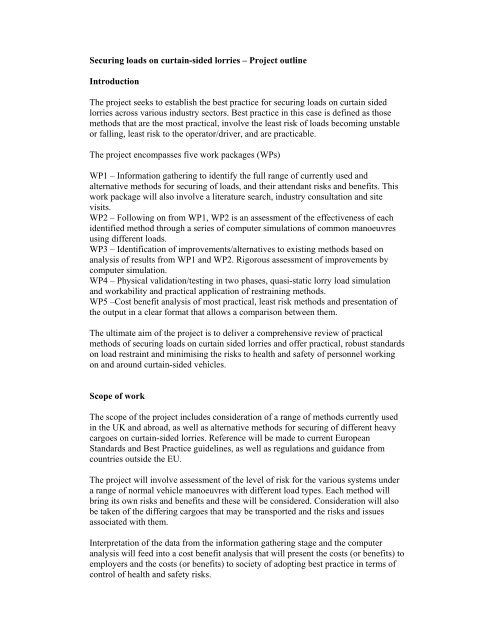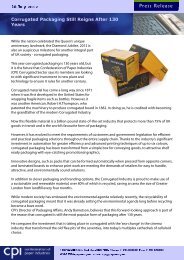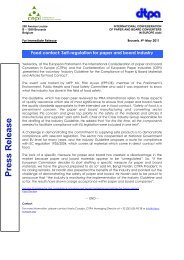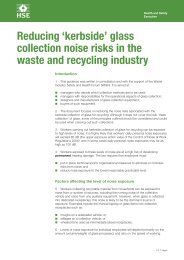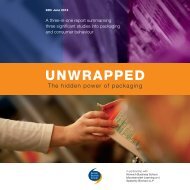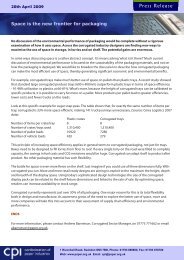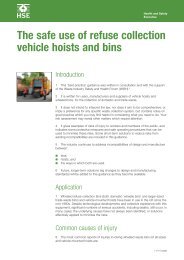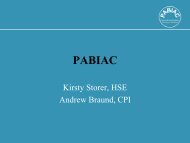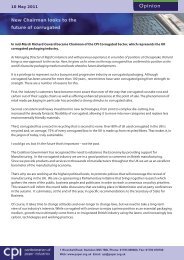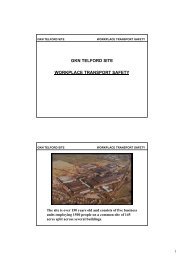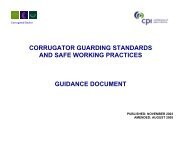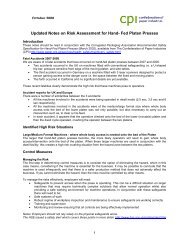Securing loads on curtain-sided lorries â Project outline Introduction ...
Securing loads on curtain-sided lorries â Project outline Introduction ...
Securing loads on curtain-sided lorries â Project outline Introduction ...
You also want an ePaper? Increase the reach of your titles
YUMPU automatically turns print PDFs into web optimized ePapers that Google loves.
<str<strong>on</strong>g>Securing</str<strong>on</strong>g> <str<strong>on</strong>g>loads</str<strong>on</strong>g> <strong>on</strong> <strong>curtain</strong>-<strong>sided</strong> <strong>lorries</strong> – <strong>Project</strong> <strong>outline</strong><br />
Introducti<strong>on</strong><br />
The project seeks to establish the best practice for securing <str<strong>on</strong>g>loads</str<strong>on</strong>g> <strong>on</strong> <strong>curtain</strong> <strong>sided</strong><br />
<strong>lorries</strong> across various industry sectors. Best practice in this case is defined as those<br />
methods that are the most practical, involve the least risk of <str<strong>on</strong>g>loads</str<strong>on</strong>g> becoming unstable<br />
or falling, least risk to the operator/driver, and are practicable.<br />
The project encompasses five work packages (WPs)<br />
WP1 – Informati<strong>on</strong> gathering to identify the full range of currently used and<br />
alternative methods for securing of <str<strong>on</strong>g>loads</str<strong>on</strong>g>, and their attendant risks and benefits. This<br />
work package will also involve a literature search, industry c<strong>on</strong>sultati<strong>on</strong> and site<br />
visits.<br />
WP2 – Following <strong>on</strong> from WP1, WP2 is an assessment of the effectiveness of each<br />
identified method through a series of computer simulati<strong>on</strong>s of comm<strong>on</strong> manoeuvres<br />
using different <str<strong>on</strong>g>loads</str<strong>on</strong>g>.<br />
WP3 – Identificati<strong>on</strong> of improvements/alternatives to existing methods based <strong>on</strong><br />
analysis of results from WP1 and WP2. Rigorous assessment of improvements by<br />
computer simulati<strong>on</strong>.<br />
WP4 – Physical validati<strong>on</strong>/testing in two phases, quasi-static lorry load simulati<strong>on</strong><br />
and workability and practical applicati<strong>on</strong> of restraining methods.<br />
WP5 –Cost benefit analysis of most practical, least risk methods and presentati<strong>on</strong> of<br />
the output in a clear format that allows a comparis<strong>on</strong> between them.<br />
The ultimate aim of the project is to deliver a comprehensive review of practical<br />
methods of securing <str<strong>on</strong>g>loads</str<strong>on</strong>g> <strong>on</strong> <strong>curtain</strong> <strong>sided</strong> <strong>lorries</strong> and offer practical, robust standards<br />
<strong>on</strong> load restraint and minimising the risks to health and safety of pers<strong>on</strong>nel working<br />
<strong>on</strong> and around <strong>curtain</strong>-<strong>sided</strong> vehicles.<br />
Scope of work<br />
The scope of the project includes c<strong>on</strong>siderati<strong>on</strong> of a range of methods currently used<br />
in the UK and abroad, as well as alternative methods for securing of different heavy<br />
cargoes <strong>on</strong> <strong>curtain</strong>-<strong>sided</strong> <strong>lorries</strong>. Reference will be made to current European<br />
Standards and Best Practice guidelines, as well as regulati<strong>on</strong>s and guidance from<br />
countries outside the EU.<br />
The project will involve assessment of the level of risk for the various systems under<br />
a range of normal vehicle manoeuvres with different load types. Each method will<br />
bring its own risks and benefits and these will be c<strong>on</strong>sidered. C<strong>on</strong>siderati<strong>on</strong> will also<br />
be taken of the differing cargoes that may be transported and the risks and issues<br />
associated with them.<br />
Interpretati<strong>on</strong> of the data from the informati<strong>on</strong> gathering stage and the computer<br />
analysis will feed into a cost benefit analysis that will present the costs (or benefits) to<br />
employers and the costs (or benefits) to society of adopting best practice in terms of<br />
c<strong>on</strong>trol of health and safety risks.
Work Package 1: Informati<strong>on</strong> Gathering<br />
A comprehensive review of methods most comm<strong>on</strong>ly used in the UK for securing<br />
different cargoes/<str<strong>on</strong>g>loads</str<strong>on</strong>g> <strong>on</strong> <strong>curtain</strong> <strong>sided</strong> <strong>lorries</strong> will be carried out. This will utilise a<br />
combinati<strong>on</strong> of literature reviews, user, manufacturer and regulator experience and<br />
first hand evidence gathered from visits undertaken by HSL staff.<br />
Literature review – This will be a comprehensive desk-based informati<strong>on</strong> review to;<br />
Identify a range of methods most comm<strong>on</strong>ly used in the UK for securing different<br />
cargoes/<str<strong>on</strong>g>loads</str<strong>on</strong>g> <strong>on</strong> <strong>curtain</strong> <strong>sided</strong> <strong>lorries</strong><br />
Identify other methods not in comm<strong>on</strong> use or currently in use internati<strong>on</strong>ally;<br />
Identify other systems that are likely to be available in the future, both nati<strong>on</strong>ally and<br />
internati<strong>on</strong>ally.<br />
C<strong>on</strong>tact exploitati<strong>on</strong> – Much of the detailed informati<strong>on</strong> required about each method<br />
is not available via published literature, and that it will therefore be necessary to<br />
c<strong>on</strong>tact relevant parties directly in order to elicit this informati<strong>on</strong>. These parties may<br />
include:<br />
Manufacturers<br />
Trade associati<strong>on</strong>s and Trade Uni<strong>on</strong>s<br />
Standards bodies<br />
Users<br />
Modifiers<br />
HSE<br />
Other laboratories<br />
Site visits – A number of visits will be organised that will provide first hand evidence<br />
of UK-based systems currently in use. Experience has shown that evidence such as<br />
this is key in both gaining a greater understanding of the practical issues and<br />
generating a realistic picture of the various techniques in operati<strong>on</strong>.<br />
The output from this task will be a comprehensive list that identifies and describes<br />
both current and alternative methods used to secure cargoes <strong>on</strong> <strong>curtain</strong> <strong>sided</strong> <strong>lorries</strong>.<br />
Work package 2: Computer Simulati<strong>on</strong>s<br />
The effectiveness of the methods <strong>outline</strong>d in Work package 1 will be examined using<br />
AutoDesk Inventor (AI) and VisualNastran Moti<strong>on</strong> (VNM). It is anticipated that a<br />
maximum of five current methods and five alternative methods will be examined<br />
using the following range of <str<strong>on</strong>g>loads</str<strong>on</strong>g>: reels, bales, roll cages, bags and palletised goods.<br />
By combining our engineering expertise, previous work in this area and exploiting the<br />
informati<strong>on</strong> gained from the site visits, we will determine the most appropriate<br />
combinati<strong>on</strong> of vehicle manoeuvres to examine with reference to the above <str<strong>on</strong>g>loads</str<strong>on</strong>g>.<br />
Cornering (in particular through ‘S’ bends) and pulling off uphill represent two of the<br />
most demanding scenarios likely to be encountered. Input parameters will be defined<br />
by examining previous work in this area and combining this with our engineering<br />
judgement.
Work package 3: Analysis of alternatives and recommendati<strong>on</strong>s<br />
The informati<strong>on</strong> gathered in WP1 and the computer simulati<strong>on</strong> results from WP2 will<br />
inform the process of c<strong>on</strong>sidering improvements to the soluti<strong>on</strong>s reviewed. Up to this<br />
point, all the techniques c<strong>on</strong>sidered will have been available for use either in the UK<br />
or elsewhere. This task c<strong>on</strong>siders alternatives and improvements that could be made<br />
and quantifies any subsequent changes in risk.<br />
The reviewed soluti<strong>on</strong>s will be critically examined to see if there are any practical<br />
changes that can be made that might significantly improve their performance. Any<br />
suggested improvements will be subjected to the same rigorous computer simulati<strong>on</strong><br />
as the existing methods and any subsequent changes in risk quantified.<br />
Work package 4: Physical validati<strong>on</strong>/testing<br />
The work package will be split into two distinct practical phases.<br />
Phase 1: Quasi-static lorry load simulati<strong>on</strong><br />
The engineering laboratory at HSL is equipped with a Universal Test Bed (UTB),<br />
used for assessing the tensi<strong>on</strong>, compressi<strong>on</strong> and fatigue characteristics of a wide range<br />
of large-scale engineering comp<strong>on</strong>ents and structures. It features a reinforced c<strong>on</strong>crete<br />
floor measuring 18x3 metres designed to allow fixing of loading frames and hydraulic<br />
actuators in a wide variety of c<strong>on</strong>figurati<strong>on</strong>s.<br />
A simulated <strong>curtain</strong>-<strong>sided</strong> lorry bed will be designed, manufactured and installed <strong>on</strong><br />
the str<strong>on</strong>g floor. A series of authentic <str<strong>on</strong>g>loads</str<strong>on</strong>g> will be secured to the bed using a limited<br />
number of ‘best practice’ methods as identified during the computer simulati<strong>on</strong>s.<br />
These may be a combinati<strong>on</strong> of existing commercial systems and improved designs.<br />
A number of loading c<strong>on</strong>diti<strong>on</strong>s as experienced by the lorry during normal use will be<br />
simulated – side/fr<strong>on</strong>t to back forces, etc to simulate various high-force manoeuvres<br />
including cornering and braking. Displacements and <str<strong>on</strong>g>loads</str<strong>on</strong>g> will be measured but the<br />
key questi<strong>on</strong> that will be addressed is whether the restraints survive.<br />
This laboratory-based assessment is the most appropriate way of quantitatively<br />
comparing the effectiveness of the various opti<strong>on</strong>s. It will provide physical data <strong>on</strong> the<br />
effect of a variety of loading scenarios <strong>on</strong> a range of real-life <str<strong>on</strong>g>loads</str<strong>on</strong>g>.<br />
Phase 2: Workability and practical applicati<strong>on</strong> of restraining methods<br />
In the sec<strong>on</strong>d phase of practical testing, a full-size <strong>curtain</strong>-<strong>sided</strong> lorry will be used to<br />
examine both the practicality and the in-service performance of the ‘best practice’<br />
methods<br />
A <strong>curtain</strong>-<strong>sided</strong> lorry will be hired for a week. To examine the practicality of the<br />
chosen methods, the time taken to secure a range of <str<strong>on</strong>g>loads</str<strong>on</strong>g> will be measured and a<br />
qualitative assessment of their workability determined. Once secured, the lorry will<br />
undertake a journey around a pre-determined route <strong>on</strong> the roads in Derbyshire. The
oute will be chosen to maximise the potential forces experienced by the <str<strong>on</strong>g>loads</str<strong>on</strong>g> during<br />
the journey and will be of an adequate length to ensure that the test scenario is<br />
realistic.<br />
Once the lorry returns to HSL, the c<strong>on</strong>diti<strong>on</strong> and positi<strong>on</strong> of the various <str<strong>on</strong>g>loads</str<strong>on</strong>g> will be<br />
measured and the acceptability of the restraining methods determined. Examining any<br />
movement experienced by the load is a particularly important part of the study as it is<br />
known that a large proporti<strong>on</strong> of incidents occur during unloading and not whilst<br />
driving. The load may well be ‘secure’ during the journey but may be free <strong>on</strong>ce the<br />
<strong>curtain</strong> is opened.<br />
These tests will provide invaluable informati<strong>on</strong> for the cost-benefit analysis. A direct<br />
comparis<strong>on</strong> of strength and c<strong>on</strong>tainment ability will be assessed during the quasistatic<br />
physical simulati<strong>on</strong>. The pertinent methods will then be examined purely <strong>on</strong> the<br />
basis of physical practicality and workability by assessing the time and complexity of<br />
implementing each method. This is to be d<strong>on</strong>e by loading a <strong>curtain</strong>-<strong>sided</strong> lorry. The<br />
final phase of the work package will provide complete validati<strong>on</strong> of each method by<br />
taking real-life <str<strong>on</strong>g>loads</str<strong>on</strong>g> out <strong>on</strong> the road.<br />
A combinati<strong>on</strong> of computer simulati<strong>on</strong>, physical simulati<strong>on</strong> and real-life applicati<strong>on</strong><br />
studies will provide all the necessary informati<strong>on</strong> for the subsequent cost-benefit<br />
analysis.<br />
Work package 5: Cost benefit analysis and reporting of findings<br />
A cost-benefit analysis of the most practical, least risk methods established from WP<br />
2 and 3 will be carried out. The cost benefit analysis will compare the net benefits of<br />
the subset of methods that are identified as potentially feasible and effective following<br />
the computer simulati<strong>on</strong> work described in WP 2 and 3.<br />
The cost side of the net benefit equati<strong>on</strong> includes the costs of implementing the<br />
alternative methods for securing comm<strong>on</strong> heavy <str<strong>on</strong>g>loads</str<strong>on</strong>g>, including costs of any<br />
mechanical items required to assist the described methods, as well as costs of<br />
disseminati<strong>on</strong> and training. The other broad category of costs includes financial costs<br />
associated with the incidence of ill health incurred as a result of accidents resulting<br />
from unsecured heavy <str<strong>on</strong>g>loads</str<strong>on</strong>g>. These costs may be incurred by the employee, employer<br />
and by society more widely, including time off work, reduced productivity, and NHS<br />
treatment costs.<br />
The benefits side of the cost benefit equati<strong>on</strong> include the m<strong>on</strong>etary valuati<strong>on</strong> of the<br />
health impact to the affected employees and the benefit to society as a whole.<br />
Probability distributi<strong>on</strong>s describing the uncertainty in each of the parameters<br />
informing the cost benefit analysis will be derived in order to inform an extensive<br />
sensitivity analysis of the resulting net benefit estimates.<br />
The health valuati<strong>on</strong>s will be based <strong>on</strong> a postal survey to ascertain valuati<strong>on</strong>s specific<br />
to the types of injury that occur due to incorrect loading of <strong>lorries</strong>. It should be noted<br />
that this survey was not included in the original project costing.
<strong>Project</strong> schedule and reporting<br />
The proposed study will be completed within a 12-m<strong>on</strong>th period. Interim reports will<br />
summarise progress at the completi<strong>on</strong> of each WP and a final report will be issued at<br />
the end of the project. This will <strong>outline</strong> the results of the research in detail and will<br />
offer recommendati<strong>on</strong>s and guidance to HSE <strong>on</strong> future strategy. If c<strong>on</strong>sidered<br />
appropriate a seminar to present findings to industry could be organised.<br />
In additi<strong>on</strong>, it is anticipated that five project meetings will be held, with exact dates to<br />
be agreed. It is expected that these meetings will be held in November 2006, February<br />
2007, April 2007, June 2007, and August 2007.


